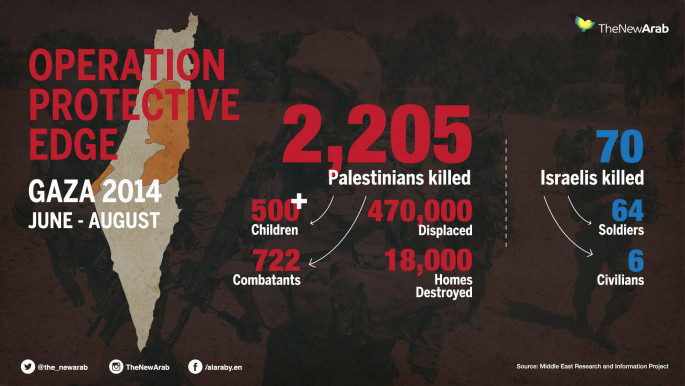Gaza's devastation two years on: calm suffering
Israel's most shattering military action in Gaza since the start of the 1967 occupation killed over 2,200 people and completely destroyed over 9,000 homes. This ferocious wave was unleashed on the already strained and besieged Palestinian strip - a place often described as the "world's largest open air prison".
Rebuilding to recovery?
According to a UN report released on Friday, over half of the homes partially damaged in the 2014 conflict have been rebuilt, alongside a third of homes that were completely destroyed. This effort to re-house the 100,000 or so Gazans who were made homeless is largely due to the efforts of non-governmental organisations backed by donors, UN bodies, private firms and the homeowners themselves.
This progress has been coupled with the reconstruction of all 78 hospitals, clinics and schools that were damaged. The restoration of the infrastructure that was crippled by the Israeli bombardment is ongoing.
Despite this positive picture, however, the UN warns that Gaza's revival cannot be quantified in bricks and mortar.
"While progress is unequivocally underway, repairing the damages from the 51-day hostilities cannot be our only measure of success, given that humanitarian and socio-economic indicators were already so dire before 2014" cautioned Robert Piper, UN Coordinator for Humanitarian Aid and Development Activities.
Considering that Gaza was already on a backfoot prior to the Israeli incursion, current progress should not be a cause for international inertia and stagnancy.
Gaza was already facing crippling shortages under Israeli and Egyptian blockade, described by Human Rights Watch in 2013 as something that had already "impeded the rebuilding of Gaza's devastated economy by blocking virtually all exports from Gaza".
 |
Blocked funding
At present, despite generous donations from the international community, much of the money directed towards Gaza's recovery is not reaching its target.
For instance, a donation of $3.5 billion pledged by benefactors in Washington in 2014 has still not reached Gaza in its entirety. As of April this year, the World Bank estimated that only 40 percent of the funds had been disbursed.
While the specific cause of this is unknown, stringent Israeli controls on funds entering Gaza add to the pressures and constraints on NGOs working on reconstruction. In addition to this, it has been alleged that the Palestinian Authority has redirected funds elsewhere, including to Ramallah where the body is based.
Adding to funding issues is the fact that sympathy for Gaza's plight has been overshadowed in recent years by other humanitarian disasters in the region, including in Syria and Yemen.
Thus, despite gestures of goodwill by the international community, investment in Gaza's reconstruction is still seriously lacking. This puts the lives of the 65,000 Gazans who remain displaced in huge uncertainty as they continue to live in temporary dwellings.
 |
Sympathy for Gaza's plight has been overshadowed in recent years by other humanitarian disasters in the region, including in Syria and Yemen |  |
Wounds that remain
Although efforts to rebuild Gaza's physical landscape are underway, it remains that the human destruction meted out by the IDF is perhaps the most irreparable.
Gazans remain under siege, with its population of 1.9 million still reeling from the terror of 2014. Israel continues to conduct operations on the territory, with Gaza's residents living in fear of when the next major incursion will be launched.
This has created a generation of Palestinian children whose youth will have been defined by war and seige, perhaps fuelling decades more resentment and antagonism. In turn, Israeli authorities continue to use the militarisation of some elements of Gaza's population as a premise for further destruction.
"We must reverse Gaza's de-development trajectory and address the needs of a population that has gone through three rounds of conflict, nine years of an Israeli blockade and the consequences of the Palestinian internal divide which, combined, have affected every aspect of their daily lives," Piper warns.
"Accountability for violations of international law by duty bearers on both sides during the war also remains elusive, denying victims and survivors the justice and redress they deserve."





 Follow the Middle East's top stories in English at The New Arab on Google News
Follow the Middle East's top stories in English at The New Arab on Google News


